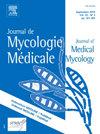Cryptococcal meningoencephalitis in a patient on immunomodulatory drug: A case report
IF 1.8
4区 医学
Q3 MYCOLOGY
引用次数: 0
Abstract
Background
Cryptococcus neoformans is an important fungal pathogen causing pneumonia and central nervous system infections mainly in immunocompromised hosts. Fingolimod is an immunomodulatory drug approved in the US and Europe for the treatment of multiple sclerosis.
Case presentation
We herein report a case of cryptococcal meningoencephalitis in a 46-year-old male with a history of fingolimod for five years. He suffered from a progressive headache and visual impairment. These symptoms led to a suspicion of a central nervous system infection and C. neoformans was identified with nucleic acid-based PCR method. Subsequently, appropriate treatment was initiated, and the patient recovered.
Conclusions
Our case underlines the importance of active diagnostic measures such as cerebrospinal fluid analysis in patients under fingolimod treatment with central nervous symptoms. While multiple sclerosis may cause headache and vision impairment, similar symptoms may be caused by central nervous system infections. It has been suggested that fingolimod may subject one to infections and this may occur even years after initiation of the treatment. For our case patient Cerebrospinal fluid sample combined with PCR-based identification provided a rapid diagnosis.
一名服用免疫调节药物患者的隐球菌脑膜脑炎:病例报告。
背景:新型隐球菌是一种重要的真菌病原体,主要在免疫功能低下的宿主中引起肺炎和中枢神经系统感染。芬戈莫是一种免疫调节药物,在美国和欧洲被批准用于治疗多发性硬化症。病例介绍:我们在此报告一例隐球菌性脑膜脑炎,46岁男性,芬戈莫德病史5年。他患有进行性头痛和视力障碍。这些症状导致怀疑中枢神经系统感染,并以核酸为基础的PCR方法鉴定了新型弓形虫。随后,进行了适当的治疗,患者得以康复。结论:我们的病例强调了积极诊断措施的重要性,如脑脊液分析,在接受芬戈莫德治疗的中枢神经症状患者。多发性硬化症可能引起头痛和视力损害,类似的症状也可能由中枢神经系统感染引起。有人建议,芬戈莫德可能使人感染,甚至可能在开始治疗数年后发生。对于我们的病例,脑脊液样本结合pcr鉴定提供了快速诊断。
本文章由计算机程序翻译,如有差异,请以英文原文为准。
求助全文
约1分钟内获得全文
求助全文
来源期刊
CiteScore
5.10
自引率
2.80%
发文量
68
审稿时长
6-12 weeks
期刊介绍:
The Journal de Mycologie Medicale / Journal of Medical Mycology (JMM) publishes in English works dealing with human and animal mycology. The subjects treated are focused in particular on clinical, diagnostic, epidemiological, immunological, medical, pathological, preventive or therapeutic aspects of mycoses. Also covered are basic aspects linked primarily with morphology (electronic and photonic microscopy), physiology, biochemistry, cellular and molecular biology, immunochemistry, genetics, taxonomy or phylogeny of pathogenic or opportunistic fungi and actinomycetes in humans or animals. Studies of natural products showing inhibitory activity against pathogenic fungi cannot be considered without chemical characterization and identification of the compounds responsible for the inhibitory activity.
JMM publishes (guest) editorials, original articles, reviews (and minireviews), case reports, technical notes, letters to the editor and information. Only clinical cases with real originality (new species, new clinical present action, new geographical localization, etc.), and fully documented (identification methods, results, etc.), will be considered.
Under no circumstances does the journal guarantee publication before the editorial board makes its final decision.
The journal is indexed in the main international databases and is accessible worldwide through the ScienceDirect and ClinicalKey platforms.

 求助内容:
求助内容: 应助结果提醒方式:
应助结果提醒方式:


